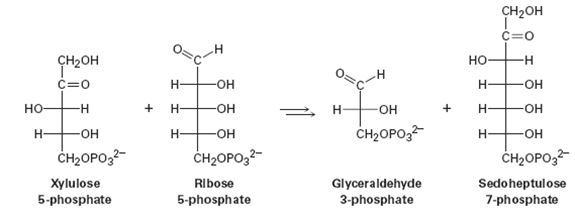
Concept explainers
One of the steps in the pentose phosphate pathway for glucose catabolism is the reaction of xylulose 5-phosphate with ribose 5-phosphate in the presence of a transketolase to give glyceraldehyde 3-phosphate and sedoheptulose 7-phosphate.

(a) The first part of the reaction is nucleophilic addition of thiamin diphosphate (TPP) ylide to xylulose 5-phosphate, followed by a retro-aldol cleavage to give glyceraldehyde 3-phosphate and a TPPcontaining enamine. Show the structure of the enamine and the mechanism by which it is formed.
(b) The second part of the reaction is addition of the enamine to ribose 5-phosphate followed by loss of TPP ylide to give sedoheptulose 7-phosphate. Show the mechanism.
Trending nowThis is a popular solution!

Chapter 29 Solutions
Bundle: Organic Chemistry, 9th, Loose-Leaf + OWLv2, 4 terms (24 months) Printed Access Card
Additional Science Textbook Solutions
College Physics: A Strategic Approach (3rd Edition)
Physical Science
Organic Chemistry
Applications and Investigations in Earth Science (9th Edition)
- 7. Draw the Lewis structures and molecular orbital diagrams for CO and NO. What are their bond orders? Are the molecular orbital diagrams similar to their Lewis structures? Explain. CO Lewis Structure NO Lewis Structure CO Bond Order NO Bond Order NO Molecular Orbital Diagram CO Molecular Orbital Diagramarrow_forward5. The existence of compounds of the noble gases was once a great surprise and stimulated a great deal of theoretical work. Label the molecular orbital diagram for XeF (include atom chemical symbol, atomic orbitals, and molecular orbitals) and deduce its ground state electron configuration. Is XeF likely to have a shorter bond length than XeF+? Bond Order XeF XeF+arrow_forward6. Draw the molecular orbital diagram shown to determine which of the following is paramagnetic. B22+ B22+, B2, C22, B22 and N22+ Molecular Orbital Diagram B2 C22- B22- N22+ Which molecule is paramagnetic?arrow_forward
- 3. Put the following species in order of increasing bond length by using molecular orbital diagrams and calculating their bond orders: F2, F2, F2+ Molecular Orbital Diagram F2 F2 F2+ Bond Order Shortest bond: Longest bondarrow_forward3. Put the following species in order of increasing bond length by using molecular orbital diagrams and calculating their bond orders: F2, F2, F2+ Molecular Orbital Diagram F2 F2 F2+ Bond Orderarrow_forward4. The superoxide ion, Oz, plays an important role in the ageing processes that take place in organisms. Judge whether Oz is likely to have larger or smaller dissociation energy than 02. Molecular Orbital Diagram 02 02 Does O2 have larger or smaller dissociation energy?: Bond Orderarrow_forward
